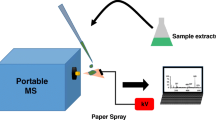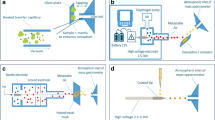Abstract
The opium poppy (Papaver somniferum) is a global commercial crop that has been historically valued for both medicinal and culinary purposes. Naturally occurring opium alkaloids including morphine, codeine, thebaine, noscapine, and papaverine are found primarily in the latex produced by the plant. If the plant is allowed to fully mature, poppy seeds that do not contain the opium alkaloids will form within the pods and may be used in the food industry. It is possible for the seeds to become contaminated with alkaloids by the latex during harvesting, posing a potential health risk for consumers. In the USA, there have been more than 600 reported adverse events including 19 fatalities that may be linked to the consumption of a contaminated poppy-containing product such as home-brewed poppy seed tea. Unwashed poppy seeds and pods may be purchased over the Internet and shipped worldwide. The Forensic Chemistry Center, US Food and Drug Administration (FDA) has evaluated several mass spectrometers (MS) capable of rapid screening to be used for high-throughput analysis of samples such as poppy seeds. These include a direct analysis in real-time (DART) ambient ionization source coupled to a single-quadrupole MS, an atmospheric solids analysis probe (ASAP) ionization source coupled to the same MS, and ion mobility spectrometers (IMS). These instruments have been used to analyze 17 poppy seed samples for the presence of alkaloids, and the results were compared to data obtained using liquid chromatography with mass spectral detection (LC–MS/MS). Results from the 17 poppy seed samples indicate that the DART-MS, ASAP-MS, and IMS devices detect many of the same alkaloids confirmed during the LC–MS/MS analyses, although both the false-positive and false-negative rates are higher, possibly due to the non-homogeneity of the samples and the lack of chromatographic separation.
Graphical Abstract






Similar content being viewed by others
References
Drug Enforcement Administration; Diversion Control Division; Unwashed Poppy Seed; DEA PRB 11–15–19–44. 2019. https://www.deadiversion.usdoj.gov/drug_chem_info/unwashed_poppy_seed.pdf
Borg T. Commission Recommendation of 10 September 2014 on good practices to prevent and to reduce the presence of opium alkaloids in poppy seeds and poppy seed products. Offical J Eur Union. 2014;662:96–100.
Haber I, Pergolizzi J, LeQuang JA. Poppy seed tea: a short review and case study. Pain Therapy. 2019;8(1):151–5.
Woodcock J. FDA’s Budget: Advancing the goal of ending the opioid crisis. 2022. https://www.fda.gov/news-events/fda-voices/fdas-budget-advancing-goal-ending-opioid-crisis#
Lanzarotta A, Kern SE, Batson J, Falconer TM, Fulcher M, Gaston KW, et al. Evaluation of a “toolkit” consisting of handheld and portable analytical devices for detecting active pharmaceutical ingredients in drug products collected during a simultaneous nation-wide mail blitz. J Pharm Biomed Anal. 2021;203: 114183.
Lanzarotta A, Kern SE, Batson J, Boyd B, Kimani MM, Kuo W, et al. Rapid detection of active pharmaceutical ingredients in drug products collected at an international mail facility by a satellite laboratory using a “toolkit” consisting of a handheld Raman spectrometer, portable mass spectrometer and portable FT-IR spectrometer. J Pharm Biomed Anal. 2023;224: 115153.
Kern SE, Toomey VM, Lorenz LM. Rapid-field-deployable DART-MS screening technique for 87 opioids and drugs of abuse, including fentanyl and fentanyl analogs. J Regul Sci. 2022;10(2):1–14.
Sisco E, Forbes TP, Staymates ME, Gillen G. Rapid analysis of trace drugs and metabolites using a thermal desoprtion DART-MS configuration. Analytical Methods. 2016;8:6494–9.
Sisco E, Robinson EL, Burns A, Mead R. What’s in the bag? Analysis of exterior drug packaging by TD-DART-MS to predict the contents. Forensic Sci Int. 2019;304:1–7.
Sisco E, Verkouteren J, Staymates J, Lawrence J. Rapid detection of fentanyl, fentanyl analogues, and opioids for an on-site or laboratory based drug seizure screening using thermal desorption DART-MS and ion mobility spectrometry. Forensic Chem. 2017;4:108–15.
Kern SE, Crowe JB, Litzau JJ, Heitkemper DT. Forensic analysis of stains on fabric using direct analysis in real-time ionization with high-resolution accurate mass-mass spectrometry. J Forensic Sci. 2018;63(2):592–7.
Duvivier WF, Beek TAv, Pennings EJM, Nielen MWF. Rapid analysis of 9-tetrahydrocannabinol in hair using direct analysis in real time ambient ionization Orbitrap mass spectrometry. Rapid Commun Mass Spectrom. 2014;28:682 - 90.
Jones RW, McClelland JF. Analysis of writing inks on paper using direct analysis in real time mass spectrometry. Forensic Sci Int. 2013;231:73–81.
Forbes TP. Forensic analysis and differentiation of black powder and black powder substitute chemical signatures by infrared thermal desorption-DART-MS. Anal Chem. 2019;91:1089–97.
Forbes TP, Sisco E, Staymates M. Detection of nonvolatile inorganic oxidizer-based explosives from wipe collections by infrared thermal desorption direct analysis in real time mass spectrometry. Anal Chem. 2018;90:6419–25.
Sisco E, Forbes TP. Forensic applications of DART-MS: a review of recent literature. Forensic Chemistry. 2021;22: 100294.
Zaknoun H, Binette M-J, Tam M. Analyzing fentanyl and fentanyl analogues by ion mobility spectrometry. Int J Ion Mobil Spectrom. 2019;22:1–10.
Brown HM, McDaniel TJ, Fedick PW. The current role of mass spectrometry in forensics and future prospects. Anal Methods. 2020;12:3974–97.
Sorribes-Soriano A, Guardia Mdl, Esteve-Turrillas FA, Armenta S. Trace analysis by ion mobility spectrometry: from conventional to smart sample preconcentration methods. A review. Anal Chim Acta. 2018;1026:37 - 50.
Voelker SE, Kern SE, Falconer TM, Thatcher MD, Skelton DM, Gaston KW, et al. Evaluation of four field portable devices for the rapid detection of mitragynine in suspected kratom products. J Pharm Biomed Anal. 2021;201. https://doi.org/10.1016/j.jpba.2021.114104
McCullough BJ, Patel K, Francis R, Cain P, Douce D, Whyatt K, et al. Atmospheric solids analysis probe coupled to a portable mass spectrometer for rapid identification of bulk drug seizures. J Am Soc Mass Spectrom. 2020;31:386–93.
Powers D, Erickson S, Swortwood MJ. Quantification of morphine, codeine, and thebaine in home-brewed poppy seed tea by LC-MS/MS. J Forensic Sci. 2018;63(4):1229–35.
Lawrence A. Ion mobility spectrometry/mass spectrometry of some prescription and illicit drugs. Anal Chem. 1986;58(6):1269–72.
Acknowledgements
The authors would like to acknowledge Dr. Skyler Smith, Dr. Catherine Dasenbrock, and Mr. Jonathan Litzau for helpful discussions.
Author information
Authors and Affiliations
Corresponding author
Ethics declarations
Disclaimer
The contents of this manuscript are the author’s opinions and should not be considered as opinions or policy of the US FDA. The mention of trade names and manufacturers is for technical accuracy and should not be considered as endorsement of a specific product or manufacturer.
Conflict of interest
The authors declare no competing interests.
Additional information
Publisher's Note
Springer Nature remains neutral with regard to jurisdictional claims in published maps and institutional affiliations.
Published in the topical collection Food Safety Analysis 2.0 with guest editor Steven J. Lehotay.
Rights and permissions
About this article
Cite this article
Kern, S.E., Voelker, S.E., Lorenz, L.M. et al. Comparison of direct analysis in real-time mass spectrometry, atmospheric solids analysis probe–mass spectrometry, and ion mobility spectrometry for ensuring food safety by rapid screening of poppy seeds. Anal Bioanal Chem 416, 827–837 (2024). https://doi.org/10.1007/s00216-023-05042-6
Received:
Revised:
Accepted:
Published:
Issue Date:
DOI: https://doi.org/10.1007/s00216-023-05042-6




